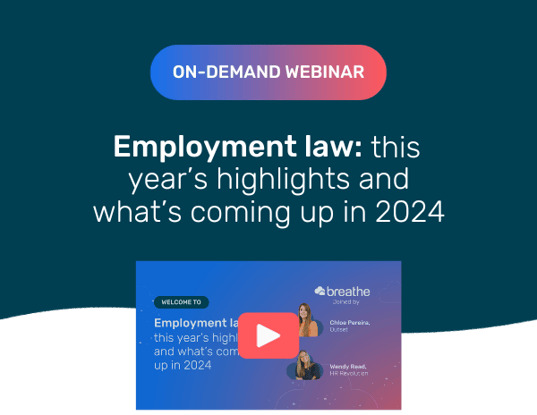Employment law can be a minefield for SMEs – especially when it comes to complex areas like discrimination.
The threat of potential tribunal claims is significant - and not following the law can cause high costs (not to mention stress) for small businesses.
This blog will help SMEs to gain a solid grasp of discrimination, with examples of case law to show what this means in reality.
We also include practical tips for small businesses to protect against these issues.
Skip to:
-
Inadequate toilet facilities - sex discrimination (direct discrimination)
-
Employer should have phoned job applicant (reasonable adjustments)
What are the 9 protected characteristics?
Discrimination law is designed to safeguard individuals against unjust treatment based on specific characteristics.
The Equality Act protects the following characteristics:
-
Age: Protects individuals of all ages from unfair treatment.
-
Disability: Shields those with physical or mental impairments from discrimination.
-
Gender reassignment: Ensures protection for individuals undergoing gender identity transitions.
-
Marriage & civil partnership: Safeguards individuals based on their marital or civil partnership status.
-
Pregnancy & maternity: Protects individuals during and after pregnancy, encompassing maternity leave.
-
Race: Shields against discrimination based on race, ethnicity, or nationality.
-
Religion or belief: Ensures protection for individuals with specific religious or philosophical beliefs.
-
Sex: Guards against discrimination based on gender.
-
Sexual orientation: Provides protection for individuals based sexual orientation
What are the different types of discrimination?
Discrimination comes in many forms, as detailed in the Equality Act 2010. We’ve provided an overview of the different types:
-
Direct discrimination occurs when someone is treated less favourably than others due to a protected characteristic. An employer mustn’t make decisions based on these characteristics to ensure fair treatment.
-
Indirect discrimination arises when a seemingly neutral policy or practice puts individuals with certain protected characteristics at a disadvantage, unless the policy can be objectively justified.
-
Harassment involves unwanted conduct related to a protected characteristic that creates an intimidating, hostile, or offensive work environment. Employers bear the responsibility of preventing and addressing harassment promptly.
-
Victimisation pertains to treating someone unfavourably because they have asserted their rights under the Equality Act, such as making a discrimination complaint.
-
Instructing, causing, inducing, and/or knowingly helping someone to (or try to) discriminate, harass or victimise someone else relating to a protected characteristic is also unlawful.
-
Discrimination arising from disability is where an employer treats an employee unfavourably because of something arising from their disability. For example, dismissal for poor performance where the reason for the poor performance relates to a mental health condition.
-
Duty to make reasonable adjustments is another aspect unique to discrimination, whereby employers are under a duty to make adjustments to the workplace or practices to support disabled employees and job applicants.
Case law: examples of discrimination in action
The following cases provide context on a few of the different types of discrimination - helping employers see where incidents can easily happen (and where they can be avoided).
1. Direct discrimination: Inadequate toilet facilities can amount to sex discrimination
Case overview:
Earl Shilton Town Council v Miller (2023) is an example of where inadequate toilet facilities were considered a form of sex discrimination.
Earl Shilton Town Council operated from a church building where there was also a playgroup. The women’s toilets were in the building used by that playgroup, and to use them, the women working for the Council had to attract the attention of staff at the playgroup to make sure there were no children present before they could access the toilets.
Ms Miller argued that this was inadequate provision of toilet facilities, because the alternative offered to her was a cubicle in the men’s toilets which she would have to pass the urinals to access. This placed her at risk of seeing men using the urinals. There were also no sanitary bins available.
Tribunal ruling:
The Employment Tribunal agreed that this amounted to less favourable treatment on the grounds of sex, and was therefore direct sex discrimination. The Respondent appealed to the Employment Appeal Tribunal (EAT), arguing that:
It couldn’t be less favourable treatment because of sex, because it concerned a safeguarding issue; and
There was no less favourable treatment because a man was at risk of being observed at the urinal, which was equivalent to a woman seeing a man using the urinal
The EAT confirmed that women being at risk of seeing a man use the urinal isn’t the same as other men seeing a man using the urinal. The toilet facilities were inadequate because of that risk, and the lack of sanitary disposal.
Interestingly, following pressure from the Claimant, the Council did install a lock on the main door to the men’s toilets and install a sanitary bin. However, Ms Miller had to ask a male janitor to empty the sanitary bin, causing embarrassment and further detriment.
The Respondent argued that there wasn’t much more it could have done, short of building work, which wouldn’t have been reasonable. There was also another female employee who wasn’t bothered by the facilities. What they failed to grasp, was that they had done nothing until the Claimant pressured them to install a lock, and provide a bin, and even then, weren’t proactive in making sure arrangements were in place to have the bin emptied. Neither did it matter that another woman was less concerned about the lack of proper facilities – that didn’t detract from the detriment to Ms Miller.
Takeaways from this case:
This case provides an interesting cautionary tale for employers, not to take half measures, and to widen your viewpoint to appreciate that not everyone will have the same level of tolerance for a situation.
2. Reasonable adjustments: Employer should have phoned job applicant
Case overview:
A 2023 decision by the Employment Appeal Tribunal (EAT) in the case of AECOM Ltd v Mallon, serves as an important reminder of the duty employers have in making reasonable adjustments for candidates with disabilities during the recruitment process.
In this case, the EAT upheld the findings of a tribunal that an employer was obliged to make accommodations when a job applicant with dyspraxia encountered difficulties (due to the requirement of creating an online profile and filling out an online application form).
The applicant initially requested that he should be allowed to make an oral application due to his condition. However, he didn’t respond to the employer's attempts to understand his challenges with the online process through email communication.
Tribunal ruling:
The EAT highlighted two potential reasons for this lack of response: either the applicant aimed to manipulate a disability discrimination claim or his difficulties with written communication were genuinely an obstacle.
Once it was established that the applicant's intentions were genuine, the tribunal ruled that the employer should have recognised that his dyspraxia impeded his access to the online form, despite his non-responsive behaviour. The EAT agreed that a reasonable employer, faced with such a situation, should have taken further steps to understand the applicant's situation, potentially through a phone conversation. Given his documented difficulty with written communication, the tribunal deemed his failure to respond through email as reasonable.
However, the EAT referred back to the employment tribunal the question of the applicant's authenticity. The original tribunal had concluded that the applicant's history with the same employer (where he previously faced performance issues), might have influenced his current application. Upon re-evaluation, taking into account the right circumstances, the EAT speculated that the tribunal might come to a different conclusion.
Takeaways from this case:
This case underlines the importance of employers proactively considering reasonable adjustments for candidates with disabilities during recruitment processes. It's a reminder that a genuine effort to understand and accommodate an applicant's needs can help prevent potential claims of discrimination & create a more inclusive hiring process.
The emphasis on making reasonable adjustments for job applicants is crystal clear. The case serves as a reminder for SMEs to establish transparent procedures for accommodating diverse needs, demonstrating that going the extra mile in making adjustments isn’t only a legal obligation – but also a step toward creating an inclusive work environment.
3. Direct discrimination: Marital discrimination
Case overview:
Claims for marital discrimination aren’t very common - it’s a characteristic protected under the Equality Act that’s often forgotten about. But Ellis v Bacon and another serves as a poignant example of this unusual claim for direct discrimination, where a director faced dismissal during a divorce from a fellow director.
Direct marriage or civil partner discrimination happens if an employer treats an employee less favourably than it does or would treat others because of marriage or civil partnership.
In Ellis v Bacon, Ms Bacon was married to the Managing Director and majority shareholder of AFS, of which she was also a shareholder. Mr Ellis joined the business and was later made a shareholder and then Managing Director.
Mr and Ms Bacon later divorced, and false allegations were made that she’d misused company IT. This resulted in Mr Ellis siding with Mr Bacon and suspending, then dismissing, Ms Bacon.
Tribunal ruling:
An employment tribunal held that Mr Ellis had treated Ms Bacon less favourably because of her marriage to Mr Bacon and had therefore directly discriminated against her. However, on appeal, this was overturned.
The Employment Appeal Tribunal found (it said, with a heavy heart) that the reason for Ms Bacon’s mistreatment was not the fact that she was married, it was that her marriage was with Mr Bacon specifically. The appeal judge acknowledged that Ms Bacon was “very badly treated” by Mr Ellis, but he was bound by having to follow the law which, in this instance, was not on her side.
Takeaways from this case:
Protection from marital discrimination was first introduced because it used to be commonplace for employers to dismiss a woman once she got married. It’s therefore a narrow protection, which prevents less favourable treatment for the fact that someone is married, rather than being treated less favourably because of who they’re married to.
This all sounds like splitting hairs, but it’s a good reminder of how complex discrimination claims can be, and why employers should always exercise caution where these risks are in play.
Promoting fair, inclusive workplaces – and minimising risk for SMEs
Discrimination cases reveal lessons that go beyond the courtroom. SMEs can protect themselves with an awareness of discrimination law, a deep understanding of the 9 protected characteristics – and how discrimination isn’t always obvious.
Recognising how subtly direct & indirect discrimination can appear, understanding the obligation to make reasonable adjustments and staying informed via landmark cases are the pillars of a legally resilient workplace.
Knowledge empowers SMEs to not only comply with legal standards, but to create workplaces that champion equality and fairness.
As we navigate 2024, the call to action is clear: Stay informed, adapt & proactively implement practices that promote inclusivity, equity & respect – as well as minimising the risk to businesses.
Chloe Pereira is the Legal Director at Outset & an employment law Partner of Breathe.
Catch up with Breathe's employment law webinar on-demand where Chloe shares her thoughts on 2024's employment law landscape.

Author: Chloe Pereira - Employment law Partner & Legal Director, Outset
Chloe Pereira is Breathe's new legal expert & employment law Partner. Chloe is a seasoned employment law expert with 15 years of experience, joined Outset Group in 2016. Leading the Mid-Sector People Services team, she specialises in advising clients with 100-1,000 employees. Chloe is known for her strategic and commercial legal advice, particularly on complex employment issues like senior executive exits, TUPE matters and collective consultation.
Posted on 20 February, 2024
By Chloe Pereira - Employment law Partner & Legal Director, Outset
Employment Law






